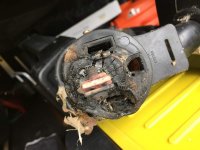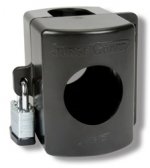TravelTiger
Founding Texas-West Chapter Leaders-Retired
Hi all,
We recently began full-timing in the ElkRidge in a new RV Park. This area of the park has new power, water and sewer hookups, installed within the last year.
We've been here about 2.5 weeks. Yesterday, while I was working on my computer and Tony was just sitting in his chair, we heard what sounded like a rock hitting the glass window, a few times in sucession. We both jumped, and said "what was that!" Then the power went out, and smoke came out of the TV (which was not on at the time.)
We immediately threw the 50amp breaker inside, and outside at the pole.
We have a SurgeGuard 50amp external protector.
We discovered that the RV's 50 amp power cord male plug had melted to the female SurgeGuard plug.


Upon more investigation yesterday and today:
1. no evidence of charing at the Marinco plug or wires to it at the back of the trailer.
2. no evidence of melting/charing at the Park Pedestal.
3. Park managers said electrician checked the Pedestal, and was OK but we did not see this (we were out getting a new power cord and SurgeGuard).
4. no evidence of burned/loose wiring at the breaker box.
5. noticeable burned wiring smell in the surge protectors plugged into a few outlets around the RV -- behind TV, back wall, bedroom (I assume they sacrificed themselves during a surge?)
6. With new power cord and new SurgeGard (all we could find near us) park power reads OK, no reverse, open, etc. New Furion power cord has lights that indicate power on both legs.
7. Checked with a Kill-o-watt, all wall and GFI outlets read approx. 120v.
8. Converter charges battery.
9. Water heater heats water.
10. Microwave warms.
11. Ceiling fan/light works.
12. one GFI plug in kitchen was tripped.
13. Both ACs turned on (separately) and cooled.
14. Fridge seems to be working OK, but since it only has a "auto" light for running on propane or AC, I cannot say for sure that AC is working.
15. The SurgeGuard "rattles" now which indicates to me it's fried.
Other observations:
- It's been 102+ here the past week, and I know we've got a lot of fans and other electrical needs plugged in.
- We got a new neighbor about a week ago, a 34ft travel trailer. These two rigs are the only ones on this branch of the park.
- This connection between power cord and protector had a plastic locking device on it, so it is very rarely disconnected. I admit we have not really looked at it recently.
- We discovered upon testing our breakers and what's on them that the plugs for the two slides, the back wall, and the MICROWAVE are on the same 15amp breaker which was not the 20 amp breaker labeled "Mic"
We have not tested any devices that were plugged into regular outlets yet to see what my have been lost.
We are not electrically inclined, so we need some sound and specific advice.
We have opted to not stay in the unit until we get this figured out.
We're not really in a position to take it to a dealer, as we are both living and working out of the coach. (staying in a motel at the moment.)
Prayers for our sanity would be helpful as well, as this is a stressful time.
We recently began full-timing in the ElkRidge in a new RV Park. This area of the park has new power, water and sewer hookups, installed within the last year.
We've been here about 2.5 weeks. Yesterday, while I was working on my computer and Tony was just sitting in his chair, we heard what sounded like a rock hitting the glass window, a few times in sucession. We both jumped, and said "what was that!" Then the power went out, and smoke came out of the TV (which was not on at the time.)
We immediately threw the 50amp breaker inside, and outside at the pole.
We have a SurgeGuard 50amp external protector.
We discovered that the RV's 50 amp power cord male plug had melted to the female SurgeGuard plug.


Upon more investigation yesterday and today:
1. no evidence of charing at the Marinco plug or wires to it at the back of the trailer.
2. no evidence of melting/charing at the Park Pedestal.
3. Park managers said electrician checked the Pedestal, and was OK but we did not see this (we were out getting a new power cord and SurgeGuard).
4. no evidence of burned/loose wiring at the breaker box.
5. noticeable burned wiring smell in the surge protectors plugged into a few outlets around the RV -- behind TV, back wall, bedroom (I assume they sacrificed themselves during a surge?)
6. With new power cord and new SurgeGard (all we could find near us) park power reads OK, no reverse, open, etc. New Furion power cord has lights that indicate power on both legs.
7. Checked with a Kill-o-watt, all wall and GFI outlets read approx. 120v.
8. Converter charges battery.
9. Water heater heats water.
10. Microwave warms.
11. Ceiling fan/light works.
12. one GFI plug in kitchen was tripped.
13. Both ACs turned on (separately) and cooled.
14. Fridge seems to be working OK, but since it only has a "auto" light for running on propane or AC, I cannot say for sure that AC is working.
15. The SurgeGuard "rattles" now which indicates to me it's fried.
Other observations:
- It's been 102+ here the past week, and I know we've got a lot of fans and other electrical needs plugged in.
- We got a new neighbor about a week ago, a 34ft travel trailer. These two rigs are the only ones on this branch of the park.
- This connection between power cord and protector had a plastic locking device on it, so it is very rarely disconnected. I admit we have not really looked at it recently.
- We discovered upon testing our breakers and what's on them that the plugs for the two slides, the back wall, and the MICROWAVE are on the same 15amp breaker which was not the 20 amp breaker labeled "Mic"
We have not tested any devices that were plugged into regular outlets yet to see what my have been lost.
We are not electrically inclined, so we need some sound and specific advice.
We have opted to not stay in the unit until we get this figured out.
We're not really in a position to take it to a dealer, as we are both living and working out of the coach. (staying in a motel at the moment.)
Prayers for our sanity would be helpful as well, as this is a stressful time.
Last edited:


